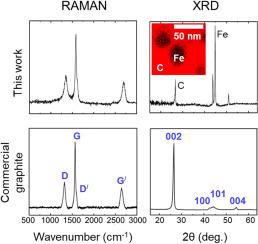Catalytic synthesis of iron-doped graphitic aerogels from poly(phloroglucinol-terephthalaldehyde – urethane) precursors
IF 3.9
Q2 MATERIALS SCIENCE, MULTIDISCIPLINARY
引用次数: 0
Abstract
We report a new class of graphitic carbon aerogel precursors based on iron oxide-doped poly(phloroglucinol-terephthalaldehyde–urethane) (T-POL/PU-FeOx) networks. The hybrid polymeric network incorporates a rigid aromatic triisocyanate, tris(4-isocyanatophenyl)methane, which reacts in situ with the hydroxyl groups of phloroglucinol to form a polyurethane-containing framework. Monolithic aerogels derived from this system undergo catalytic graphitization at significantly reduced temperatures (800–1500 °C) compared to conventional graphitization (2500–3300 °C). An oxidative ring fusion aromatization step (240 °C, air) prior to pyrolysis enhanced the degree of graphitization. The resulting graphitic aerogels were characterized by XRD, Raman spectroscopy, TGA, TEM, SEM, XPS, and N₂ sorption porosimetry. Compared to their purely phenolic analogs, graphitic carbons derived from the polyurethane-containing precursors exhibited enhanced porosity and higher surface areas. Optimal graphitization was achieved at 1500 °C, yielding aerogels primarily composed of 100 % (w/w) graphitic carbon. During pyrolysis, iron oxides facilitated carbothermal reduction to form Fe(0) nanoparticles embedded within the carbon matrix. These materials can find applications ranging from catalysis (e.g., oxygen reduction reaction - ORR) to biomedical applications (drug delivery). Additionally, none of the procedures for preparing these materials caused significant damage to the monoliths, making these materials useful for form-factor dependent applications.

以聚间苯三酚-对苯二甲酸乙二醛-聚氨酯为前驱体催化合成掺铁石墨气凝胶
我们报道了一类基于氧化铁掺杂聚间苯三酚-对苯二甲酸乙酯-聚氨酯(T-POL/PU-FeOx)网络的新型石墨碳气凝胶前驱体。混合聚合物网络包含刚性芳香三异氰酸酯,三(4-异氰酸atophenyl)甲烷,它与间苯三酚的羟基原位反应形成含聚氨酯的框架。与传统石墨化(2500-3300℃)相比,该体系衍生的单片气凝胶在显著降低的温度(800-1500℃)下进行催化石墨化。热解前的氧化环融合芳构化步骤(240℃,空气)提高了石墨化程度。采用XRD、拉曼光谱、TGA、TEM、SEM、XPS和n2吸附孔隙度等方法对所得石墨气凝胶进行了表征。与纯酚醛类似物相比,含聚氨酯前体衍生的石墨碳具有增强的孔隙率和更高的表面积。在1500°C的温度下,石墨化效果最佳,得到的气凝胶主要由100% (w/w)的石墨碳组成。在热解过程中,氧化铁促进碳热还原形成嵌入碳基体中的Fe(0)纳米颗粒。这些材料的应用范围从催化(例如氧还原反应- ORR)到生物医学应用(药物输送)。此外,制备这些材料的任何程序都不会对单体造成重大损害,这使得这些材料可用于依赖于形状因素的应用。
本文章由计算机程序翻译,如有差异,请以英文原文为准。
求助全文
约1分钟内获得全文
求助全文
来源期刊

Carbon Trends
Materials Science-Materials Science (miscellaneous)
CiteScore
4.60
自引率
0.00%
发文量
88
审稿时长
77 days
 求助内容:
求助内容: 应助结果提醒方式:
应助结果提醒方式:


